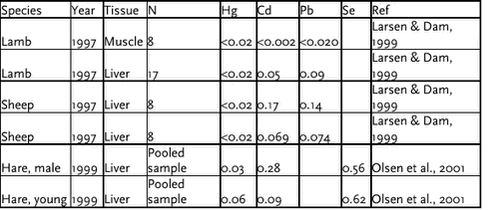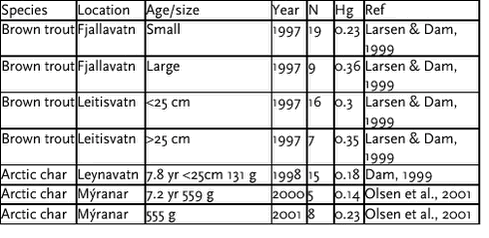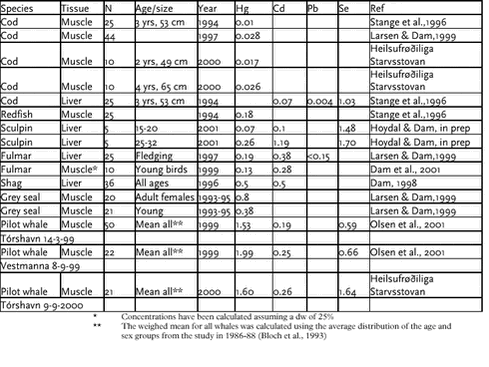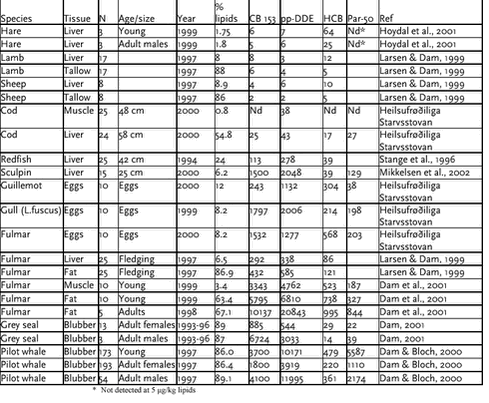AMAP Greenland and the Faroe Islands 1997-20015 The Faroe Islands. Sociocultural environment, lifestyle, health and contaminant exposure5.1 Settlement Sructure5.2 Language and Culture 5.3 Lifestyle 5.4 Disease pattern 5.5 Health Care 5.6 Contaminants in Faroese subsistence food 5.6.1 Heavy metals 5.6.2 POPs 5.6.3 Dioxins 5.6.4 Flame retardants 5.7 References By Pál Weihe, Maria Dam and Árni Olafsson 5.1 Settlement SructureThe Faroe Islands are situated in the North Atlantic 430 km south-east of Iceland, 600 km west of Norway and a good 300 km north-west of Scotland, in the same time zone as Britain. The distance to Copenhagen, the capital of Denmark, with which the Faroe Islands have constitutional links, is about 1,300 km. Of the 18 islands, 17 are inhabited. The total area is 1,399 sq.km, and the largest island is Streymoy (373.5 sq.km) with the capital, Tórshavn. The distance north-south is 113 km and east-west 75 km. The land averages 300 m above sea level. The highest point is 882 m. The islands are of volcanic origin and are part of the North Atlantic basalt region extending from Ireland to Greenland. The Ice Age glaciers formed an archipelago of mountains, deep valleys and narrow fjords and straits. The climate is oceanic: humid, changeable and windy. In Tórshavn the temperature in the coldest month averages 3 C and in the warmest 11 C. The shortest day is 5 hours and the longest 19 1/2 hours. There are no woods, but plenty of grassland. A mere 6% of the land is under cultivation while the rest is reserved for the grazing of 70,000 sheep and some cattle and horses. Birds are plentiful, especially sea birds, but other animal life is sparse. In the seas around the Faroe Islands the meeting of the warm Gulf Stream and cold northern currents rich in nutritional matter, results in rather stable ocean temperatures, between 5 and 10 C, favouring fish and animal life. The population on 31 December 2001 was 46,996 after a tenfold increase in the preceding two centuries. The birth rate is high by European standards, 1.5% in 2000. With a mortality rate of 0.7% the natural increase in population is 0.8%. A modest net emigration of earlier decades was replaced by a certain net immigration in the 1970‘ies and 1980‘ies. The early nineties saw a massive emigration, the population 1990-95 declining by 7.2%. Since 1996, however, there has been a modest net immigration. The pattern of settlement is characterised by a large number of densely populated communities differing greatly in size. There are about 100 villages and towns, of which the largest is Tórshavn with its 16,000 inhabitants including the suburbs. Second largest is Klaksvík with 4,600 inhabitants. Since 1948 the Faroe Islands have had a special autonomy status within the Kingdom of Denmark, viz home rule, seeking a balance between, on the one hand, the national uniqueness of the Faroe Islands and, on the other, maintenance of the union with Denmark. The Faroese Home Rule authorities have the legal and administrative competence in those areas, which have been taken over as special Faroese affairs. The Faroe Islands have their own flag, bank notes and stamps and also a special passport. The economy of the Faroe Islands is overwhelmingly dependent upon fisheries. Fishing, fish farming and fish processing account for a quarter of the gross factor income and almost 100% of exports. Other industries are to a great extent suppliers to the fishing industry. The remaining industries are, like the public sector, highly dependent on proceeds derived from the fishing industry. The Faroese economy is vulnerable to fluctuations in the size of the fish catch, fish prices, exchange rates and the prices of vital import products, including oil. 5.2 Language and CultureThe Faroese language is a Nordic language, closely related to Icelandic and to the dialects of Western Norway. After the reformation (c. 1540) Danish became the written language for official purposes, and Faroese went out of use in writing, but was retained as a spoken language and as a carrier of a rich “oral literature” in the form of stories and notably ballads, sung with the traditional Faroese ring-dance. In the 19th century a new written Faroese language was created on an etymological basis. After decades of political strife the Faroese language was permitted as the language of instruction in the schools (1937) and as legal language (1948). In 1998 157 books were published in Faroese, of which 96 originally Faroese and 61 translations. 5 newspapers are published, appearing from 1 to 5 times a week. The Faroese Broadcast (founded 1957) uses Faroese only. In the Faroese Television (established 1984) only part of the material is in Faroese. There is a rich theatrical and musical life based upon amateur interest, however supported by an increasing number of professional instructors. A number of records, tapes and CD‘s with Faroese music have appeared. The visual arts have a strong position. In Tórshavn the Museum of Art (Listaskálin) has a permanent collection of Faroese art. Many towns and villages have “community houses” as centres for artistic, cultural and civic activities. The most popular sport is football. The Faroese national team have since 1990 participated in international tournaments such as the qualification rounds for the European and the World Championship. A special Faroese sport is competition rowing with boats of the traditional Faroese type. 5.3 LifestyleWages are generally lower than in Denmark, and so are unemployment benefits. In the Faroe Islands, notably fishermen are used to having an income, which fluctuates in keeping with fish catches and prices. There is also a strong tradition for labour mobility, both geographically and between occupations. In the early nineties with high unemployment many Faroese went abroad to work, notably on foreign fishing vessels and in construction, but many of them are slowly drifting back again into the Faroese labour market. Due to freight costs, small units, and high indirect taxation, prices are generally higher in the Faroes, apart from books which are free of VAT, and agricultural produce, which can be bought at world market prices due to the status of the Faroe Islands outside of the Common Agricultural Policy of the EU. Nevertheless most people in the Faroese towns and villages live in fairly good and spacious, brightly painted, centrally heated houses, with most of the gadgets or conveniences considered necessary to day, including TV, video and home computer, and with a car in the garage. The numbers of smokers is the adult population is not known in detail. However, according to a school survey in 9th grade in 1999, 38% of fathers smoke daily and 42% of the mothers. The number of daily smokers among pupils in 9th. grade has declined in recent years: In 1996 37% were smoking daily, in 1997 31%, in 1998 26% and in 1999 23%. With regard to alcohol consumption, the statistics is based on sales figures. These figures indicate that the consumption in the Faroes is in the lower end of the Nordic range. The annual average alcoholic beverages in litres of pure alcohol per capita aged 15 years and over in 1990’ies was around 7 in the Faroes, 12 in Denmark and 14 in Greenland. Accordingly, the number of treatment periods/discharges from hospital for alcoholic liver diseases is low in the Faroes. The diet is dominated by marine food, e.g. cod, haddock and halibut. Seabirds are consumed in the season, especially fulmar, puffin and guillemot. However, all types of Scandinavian food items are available in the supermarkets. A part of the traditional diet consists of pilot whale meat and blubber. The pilot whale is a small whale found in large schools in the North Atlantic, the Mediterranean and a closely related species in the Pacific Ocean. The Faroese pilot whale catch is a traditional, communal, non-commercial hunt aimed at meeting the community‘s need for whale meat and blubber. The pilot whale catch proceeds as follows: A school of pilot whales, observed near the coast, is driven into a fjord and beached, preferably on a flat stretch. Only a limited number of beaches are approved for whaling. The whales are killed by a stab in the neck with a special knife. If the beaching is unsuccessful the whale is fastened by a special hook so that it can be killed in shallow water. It all looks quite dramatic, but each animal is dealt with so fast that the pain is brief. The authorities distribute the meat and blubber according to traditional rules, the main rule being equal shares for all the inhabitants of the district. No export takes place. The pilot whale is not a threatened species. As a “small cetacean” the whale is not covered by the regulations of the International Whaling Commission (IWC). Working jointly with the IWC, ICES (the International Council for the Exploration of the Sea) and NAMMCO (North Atlantic Marine Mammal Co-operation Organisation), - Faroese and international scientists keep a close watch on the size of the whale population. The most recent scientific estimate is that there are approximately 780,000 animals in the North East Atlantic. The annual catch fluctuates with oceanic conditions, but the long term average catch of approximately 1,000 animals, corresponding to only a small fraction of the annual natural rate of increase, is sustainable. Sometimes the Faroese authorities receive protests, occasionally concluding in threats of a trade boycott, which are often based on exaggerated or misleading descriptions of the whale catch. It is the position of the Faroese authorities that a sustainable harvest of pilot whales occurring in the waters around the Faroe Islands is a legitimate activity. In fact it is one of the most ecological methods of producing meat at 62 degrees Northern latitude, and only one of several examples of sensible traditional utilisation of local resources, still practiced in the Faroes. Endeavours to deprive the Faroese people of their right to harvest this resource is seen to be in violation of the UN Covenants of 1966 on Human Rights. Should the scientists so recommend, the authorities will be prepared to limit the catches. Up to now, catches are only limited in order to avoid waste. Whenever the need for whale meat and blubber is considered to be met, a whaling ban is imposed in the district concerned. The Faroese authorities have acknowledged animal welfare issues regarding the methods of catching the pilot whale. In connection with updating of the age-old rules laid down for the pilot whale hunt, the authorities have strengthened the animal welfare element, such as banning the harpoon and the whale spear and significantly reducing the use of hooks from boats. A veterinarian has been charged with the task of monitoring pilot whale hunts and implementing further improvements in killing methods. Furthermore the hunt is monitored through an international observer scheme. The Faroese do not believe that the pilot whale meat on their plate represents more animal suffering caused by humans than a similar amount of imported meat and are therefore not prepared to accept the demands for a ban on a catch which makes a larger contribution to the meat production of the islands than all the sheep and cattle put together and which covers about one quarter of the total meat consumption. 5.4 Disease patternThe disease pattern in the Faroe Islands like in Greenland is primarily known from mortality statistics, statistics on notifiable diseases, and population surveys. Life expectancy at birth is high compared with other Nordic countries both among men (75.2 years) and women (81.4 years). Infant mortality is low (1.8 per 1,000 live births for 1996-2000). The causes of death show the typical pattern of western industrialised countries, with about 40% caused by cardiovascular diseases and 30% cancer. Mortality from acute infectious diseases, suicides and accidents is unimportant. The occurrence of hepatitis B and C and HIV infections is very low. In 2000 no new cases were recorded. The number of diagnosed cases of tuberculosis is low, but possibly increasing if the figures from year 2000 indicate a trend. A major fall in the incidence of the traditionally sexually transmitted diseases, gonorrhoea and syphilis, has been seen over the last two decades. In recent years there were no notified cases of syphilis. 5.5 Health CareIn 1995, the Danish Act concerning central administration of the health care was introduced at the Faroe Islands. The Danish Act concerning the medical officers etc. also applies on the Faroe Islands. The Faroe Islands Act concerning health care came into force in 1996, and according to this Act the Faroe Islands’ home rule sets out rules concerning tasks, benefits and administration. The hospital structure and its organization, specialist fields and their organization as well as the primary health service and its organization largely follow Danish principles. The same applies to nursing homes, home nurses and home help as well as dental treatment. The health sector consists of (year 2000):
There is a central hospital in the capital and two smaller hospitals in the northern and southern parts of the islands. Complicated cases are treated in Denmark. Social legislation is generally based on the Danish model. 5.6 Contaminants in Faroese subsistence foodThere have not been any studies dedicated to elucidate the pollutant load carried by the Faroese subsistence food. However, from the results established as part of the Faroese AMAP project since 1997, and from the monitoring done by the Food and Environmental Agency, it is possible to give at least a preliminary sketch of the pollutants load in the subsistence food. In general, the selection of species and matrices studied in the Faroese AMAP program was governed by three criteria:
The latter criterion to a large extent is a question of whether the species are stationary in the Faroes or not. The species thus included in the Faroese AMAP program for Heavy Metals and Persistent Organic Pollutants (POPs) are not necessarily suitable as regular monitoring organisms, but they may have been included because of their role in the traditional diet. Some of the species, which are included in the AMAP program are analysed regularly whereas others may have been subject to occasional analyses. The species of most relevance in the Faroese diet, which have been analysed in the AMAP program are: Long-finned pilot whale (Globicephala melas), fulmar (Fulmarus glacialis), cod (Gadus morhus), sheep (Ovis aries), hare (Lepus timidus), brown trout (Salmo trutta) and Arctic char (Salvelinus alpinus). The freshwater fish species, especially the Arctic char, though an important part of the diet in other northern communities, is of limited importance as food-item in the Faroes. First and foremost due to the limited abundance of Arctic char containing waters, and secondly due to the limited catch of these fishes, which are taken on a fishing rod by sports anglers only. Blue mussels and queen scallop have once been analysed for pollutants as a part of the AMAP Faroes program. These shellfish species are widely used as food. However, in the Faroes the consumption is very limited. Consequently analyses of these shellfish species are not included in the present overview. 5.6.1 Heavy metalsMost concern has been on the metals: Mercury, lead and cadmium. Most samples have been analysed for these metals. However, in some matrices also selenium has been analysed. Lead concentrations have been shown to be generally low in the matrices analysed. Accordingly there is no special emphasis on these metals in the current analysis program. Mercury on the other hand, remains a priority metal because elevated concentrations are found in certain species, for instance the marine mammals, the seabirds and the freshwater fish. The analyses have been focused on total mercury (Hg) rather than methyl mercury (MeHg), therefore the actual amount of the latter is not known. Indications of the amount of mercury that is present in methylated form may be found in earlier studies. For instance the methyl-mercury fraction of the total mercury in pilot whale meat from 16 individuals in 1978 were found to be in the range 24 – 86%, averaging 52% of the 1.56 mgHg/kg (Juelshamn et al., 1987). There are only a very few data on MeHg in seabirds eggs in the Faroes. However, results are available for a few fulmars’ eggs, which were analysed along with some other seabirds’ eggs from the Faroes in 1972. They contained 0.21 mgHg/kg, of which 73% was MeHg. This is in the lower end of the range (Dyck og Bloch, unpubl). Table 5.6.1 Metals in terrestrial mammals, mg/kg ww.
An overview of concentrations of heavy metals in terrestrial mammals is given in Table 5.6.1. Mainly liver samples have been analysed. Unfortunately, the part of these animals that are most commonly consumed by humans, the muscles, are only rarely analysed. The reason for this is that the monitoring of pollutants in the species as such has been the focus rather than the study of the transfer of pollutants to humans. Table 5.6.2 Mercury in Freshwater fish muscle, mg/kg ww.
Mercury in two freshwater fish species is listed in Table 5.6.2. Overall, these mercury levels are in the higher end of those reported (for instance in the AMAP Assessment Report 1998). However, as earlier mentioned, freshwater fish is not likely to make up a large part of the fish intake in the Faroes, since marine species are so easily available. Therefore, the major vectors for mercury transport into the human food chain from subsistence food are presumably those listed in Table 5.6.3 Please note that sculpins are not part of the subsistence diet in the Faroes. These data were included merely because this species is used for food in other countries and is an important AMAP indicator species for the marine area. Shag liver in particular, is not to be regarded as a food item either, but shag muscle is. Unfortunately, muscle samples have not been analysed, but liver data are included to give an indication of the exposure levels. Although the actual intake of these subsistence food items are not known, it may be assumed from abundance data that fulmars are more frequently eaten than shag. Eggs of selected seabirds are also eaten, but there are hardly any data on metal concentrations in eggs at present. Table 5.6.3 Metals in marine species (fish, seabirds and mammals), in mg/kg ww
5.6.2 POPsPersistent organic pollutants have been widely found in samples from the Faroe Islands. The highest concentrations are normally found in the species from the marine compartment. In Table 5.6.4 some marker POPs are shown in selected species. The marker POPs are selected as the single isomer normally occurring in the highest concentration in their class of compounds. Thus CB 153, which makes up approx. 35-50% of the total-PCB in the bird eggs, is chosen as an indicator of PCB. Likewise, p,p‘-DDE is chosen as an indicator for the DDT group. In pilot whales p,p‘-DDE occurs in a ratio from 5.1 to 5.8 to the isomer, which occurs in next highest concentrations, which is o,p‘-DDT (lowest among the young and highest among the adult males). For toxaphene, the Parlar 50, is shown. The values are all given lipid based. This way of presenting the data is appropriate in order to compare various species and various tissues. Table 5.6.4 POPs in selected species from the Faroese environment, in µg/kg lipids.
5.6.3 DioxinsThe dioxin and non-ortho PCB concentration are known in a limited number of samples from sheep, lamb, cow‘s milk, guillemots’ eggs, cod liver and pilot whale (Mikkelsen et al., 2002). Table 5.6.5 summarises the results of these analyses. Like with the “common” POPs, the higher concentrations are found in the marine compartment. The dioxin concentration in guillemots’ eggs is high in particular. The very high proportion of “dioxin-toxicity” originating from the non-ortho PCBs (CB 77, 126 and 169) is remarkable, especially found in cod. Again guillemots’ eggs contain high concentrations of these PCBs. Table 5.6.5 Dioxin and non-ortho PCB in Faroese biota. Units are pg/g lipids of International Toxic Equivalents for PCDD/PCDF and for non-ortho PCBs those of Ahlborg et al., 1994 were used.
5.6.4 Flame retardantsPolybrominated diphenylethers have been analysed in pilot whales only. The earliest study of a school sampled in 1996 indicated very high levels of PBDE in pilot whales (Lindström et al., 1999). In this school, the levels of total BDE just exceeded 3,000 ng/g lipid in the juvenile males and females. The levels were just above 1,000 ng/g lipid in adult females; in the adult males the total BDE was 1,600 ng/g lipid. The dominating isomers were Te-BDE #47 and Pe-BDE #99, at approx. 1,700 ng/g lipid and 600 ng/g lipid in the juveniles respectively. Other penta- and hexa-brominated isomers occurred in comparable high levels. Later analyses of samples taken in subsequent years have not given as high concentrations of BDE as in this 1996 school. Comprehensive studies of the predominant POPs in pilot whales have revealed large inter-school variation. This seems to be the case for the brominated flame-retardants too. 5.7 ReferencesAhlborg, U.G., Becking, G.C., Birnbaum, L.S., Brouwer, A., Derks, H.J.G.M., Feeley, M., Golor, G., Hanberg, A., Larsen, J.C., Liem, A.K.D., Safe, S.H., Schlatter, C., Wærm, F., Younes, M., and Yrjänheikki, E., 1994. Toxic equivalency factors for dioxin-like PCBs. Report on a WHO-ECEH and IPCS consultation, december 1993. Chemosphere; 28: 1049-1067. Bloch D, Desportes G, Mouritsen R, Skaaning S, Stefansson E. An introduction to studies of the ecology and status of the Long-finned Pilot whale (Globicephala melas) off the Faroe Islands, 1986–1988. Rep Int Whal Commn 1993 a; (Special issue 14): p 1. Dam M. Hvad spiser tejst, edderfugl og top-skarv på Færøerne, og hvad er indholdet af miljøgifte i disse? Heilsufrøðiliga Starvsstovan 1998; pp.77. Dam M. Analyses of mercury and organochlorines in individual marine mammals from the Faroe Islands. Fróðskaparrit 2001; 48: 145-174. Dam M, Bloch D. Screening of mercury and persistent organochlorine pollutants in long-finned pilot whale (Globicephala melas) in the Faroe Islands. Marine Pollution Bulletin 2000; 40: 1090–1099. Dam M, Mikkelsen B, Jensen J-K. Organochlorinated pollutants in fulmars from the Faroe Islands, in prep. technical report, Food and Environmental Agency 2001. Heilsufrøðiliga Starvsstovan = Food and Environmental Agency of the Faroe Islands Hoydal K, Dam M. AMAP the Faroe Islands 1997–2001, Environment. Ministry of Environment, in prep. Hoydal, K., Olsen, J. and Dam, M, 2001. AMAP Faroe Islands 1999-2000 POPs. Food and Environmental Agency, Faroe Islands, pp 31+44. Juelshamn K, Andersen A, Ringdal O, Mørkøre J. Trace element intake in the Faroe Islands. I. Element levels in edible parts of pilot whales (Globicephala meleana) The Science of the Total Environment 1987; 65: p-53. Larsen RB, Dam M. AMAP phase I The Faroe Islands. Heilsufrøðiliga Starvsstovan 1999; 1: pp 43. G. Lindström, H. Wingfors, M. Dam & B.v. Bavel, 1999. Identification of 19 brominated diphenylethers (PBDEs) in Long-Finned Pilot Whale (Globicephala melas) from the Atlantic. Arch. of Environmental Contamination and toxicology; 36: 355-363. Mikkelsen, B, Hoydal K, Dam M, Danielsen J. ”Føroya Umhvørvi í Tølum 2001” Heilsufrøðiliga Starvstovan 2002; rapport nr. 1: pp 130. Olsen J, Hoydal K, Dam M. AMAP Faroe Islands 1999-2000 Heavy Metals. Food and Environmental Agency, Faroe Islands 2001. Stange K, Maage A, Klungsøyr J. Contaminants in fish and sediments in the North Atlantic Ocean, TemaNord 1996:522, Nordic Council og Ministers 1996; pp. 79. |




